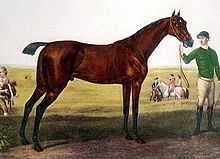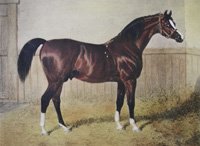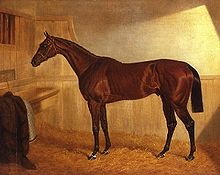Byerley Turk

The Byerley Turk (c. 1680 – c. 1703[1]), also spelled Byerly Turk, was the earliest of three stallions that were the founders of the modern Thoroughbred horse racing bloodstock (the other two are the Godolphin Arabian and the Darley Arabian).[2][3]
Background[]
The biographical details of the stallion are the subject of much speculation. The entry in the General Stud Book simply states: "BYERLY TURK, was Captain Byerly's [sic] charger in Ireland, in King William's wars (1689, &c.)."[4] As for his earlier history, the most popular theory is that the horse was captured at the Battle of Buda (1686) along with the Lister Turk, who was brought to England by the Duke of Berwick. Other sources speculate he was one of three Turkish stallions captured at the Battle of Vienna.[5] It is even possible he was bred in England from previously imported stock.[6] He was definitely the war horse of Captain Robert Byerley, who was dispatched to Ireland in 1689 during King William's War and saw further military service in the Battle of the Boyne. According to early records, Captain Byerley was nearly captured while reconnoitering the enemy, "owing his safety to the superior speed of his horse".[5]
As a general rule, the spelling of a name registered with the Jockey Club is considered definitive, even if it is an obvious error.[7] However, the original edition of the General Stud Book was compiled nearly a century after the fact (in 1791) and contains several errors that have been subsequently corrected. Most sources consider the correct spelling of the horse's name to follow the correct spelling of the owner's name, Byerley.[5]
The Byerley Turk was a dark brown or black[1] horse of unknown breeding, but described in historic accounts as an Arabian.[5] At the time, Turkish horses were described as descended from "those of Arabia or Persia", but stated that they were longer in the body and of a larger size.[8] He was described as a horse of elegance, courage and speed.[5] Many of his offspring were also noted to have been either bay or black.[9]
Stud record[]
In 1692, Captain Byerley married his cousin, Mary Wharton (sole heir to the estate of Goldsborough, near Knaresborough, North Yorkshire, England) and moved to live with her at her family home of Goldsborough Hall. After Byerley retired (as Colonel Byerley), the Byerley Turk retired to stud, first at Middridge Grange, then, from 1697, at Goldsborough Hall.[5] The Byerley Turk died there in 1703 and it is believed he is buried close to the Hall. Goldsborough Hall is now a private family home that offers accommodation, which includes the commemorative Byerley suite.[10]
He did not cover many well-bred mares,[11] but his most significant sons include:

- Black Hearty, black colt born c. 1695, "a famous Horse of Sir George Fletcher"[5]
- Grasshopper or Bristol Grasshopper, c. 1695, won the Town Plate at Nottingham under 10 stone[5]
- Jigg, c. 1701, a bay colt of middling ability[9] who became the sire of Partner, a four-time leading sire. Partner sired Tartar, who was the sire of Herod (1738).[2] Herod founded one of the three sire lines from which all modern Thoroughbreds descend, the other lines being founded by Eclipse and Matchem.
- Basto, a nearly black colt born c. 1704, who won several match races from 1708 to 1710.[12] Basto sired Old Ebony, the foundation mare of family #5.[a]
The Byerley Turk also sired several highly influential daughters, most of whose names do not survive. They are generally classified by the female family that they belong to:
- Byerley Turk mare, a black or brown daughter out of Tarfollet Barb mare, through whom all modern members of family #1 descend.[9] Family 1 is estimated to account for 15% of all thoroughbreds, and has been divided into several sub-families for ease of reference. For example, family 1-k, the family of Frankel among many others, traces back through several branches to family 1-a, Bonny Lass, a grand-daughter of the Byerley Turk mare.[13] As of 2010, there were 33 Epsom Derby winners, 31 St. Leger winners, and 40 winners of The Oaks Stakes listed in family 1 as descendants of the Byerley Turk mare[14]
- Bowes' Byerley Turk mare, the "Dam of the Two True Blues", the taproot of family 3. Though not as widespread as family 1, many classic winners around the world trace back to family 3.[15] As of 2010, there were 25 Derby winners, 26 Oaks winners and 20 St Leger winners from family 3[16]
- The Byerley Turk mare out of Bustler Mare, the taproot of family 8, which has produced 7 Oaks winners, 11 Derby winners, and 15 St Leger winners including Nijinsky[17]
- The Byerley Turk mare that was the taproot of family 17, which has produced 2 Oaks and 3 St Leger winners
- The Byerley Turk mare that was the taproot of family 41[18][19]
Byerley Turk sire line[]

The Byerley sire line persisted by producing a major sire every few generations, whose sons would create branches of their own. Most of these branches have died out over the course of time. The line of descent to the present day is as follows:[20][21][22]
- The Byerley Turk (~1680) sired in 1705, who sired Partner in 1718, who sired in 1743, who sired Herod in 1758. Herod was the leading sire in Great Britain and Ireland from 1777 to 1784
- Herod sired Highflyer in 1774, leading sire in Great Britain from 1785-1796. Highflyer's line persisted for many generations but died out in the first half of the 20th century[23]
- Herod also sired Florizel born in 1768, who sired Diomed (1777). Diomed would become a foundation sire of the American turf. In turn, Diomed sired Sir Archy who was the first great "sire of sires" in the United States. A few generations later through Sir Archy's line came Lexington who became the leading sire in North America sixteen times in the mid-19th century, but his sire line died out in the late 20th century[24][25]

- Herod's line continued through , foaled in 1773, who sired (1787). Buzzard founded several sire lines that flourished in the 19th century, most of which withered away in the 20th century[26]
- Buzzard's sire line continued through Selim, foaled in 1802, who was leading sire of 1814. Selim produced yet another flourishing sire line, most of which died away by the mid 20th century[27]
- Selim's sire line continued through Sultan, born in 1816. Sultan was leading sire 6 times

- Sultan in turn sired Bay Middleton (1833), who was leading sire in 1844 and 1849. Bay Middleton sired several sire sons but most of his line died out by the middle of the 20th century.[28]
- Bay Middleton's sire line continued through The Flying Dutchman, born in 1846. The Flying Dutchmen sired several sons whose lines gradually died out over the course of the 20th century.
- The Flying Dutchman's line continued through Dollar in 1860, who sired Androcles in 1870, who sired Cambyse in 1884, who sired Gardefeu in 1895, who sired Chouberski in 1902, who sired Bruleur in 1910, who sired Ksar in 1918.
- Ksar was a two-time winner of the Arc de Triomphe and the leading sire in France for 1931. Ksar sired Tourbillon in 1928
- Tourbillon was three-time leading sire in France. His son Djebel, born in 1937, won the Arc de Triomphe and 2,000 guineas

- Djebel sired My Babu, who also won the 2000 Guineas. The My Babu sire line persisted for several generations, leading to Cirrus des Aigles, a Group 1 winner as late as 2014. Unfortunately, Cirrus des Aigles was gelded so the My Babu sire line is on the brink of extinction.
- Djebel also sired Clarion, born in 1944, who, though less successful than My Babu on the track, is the best hope for the survival of the Byerley Turk sire line
- Clarion sired Klairon in 1952, whose son Luthier would lead the french sire list four times. Luthier's sire line continued for a few generations but seems to have died out
- Klairon also sired Lorenzaccio in 1965, who in turn sired Ahonoora in 1975
- Ahonoora proved a very successful sire, with offspring including: Don't Forget Me (2000 Guineas), Dr Devious (Epsom Derby), and Indian Ridge.
- Indian Ridge in turn has several sons and grandsons still at stud. In North America, the Indian Ridge line has hopes in Canada via Legal Jousting[29] and the United States via Final Row.[30]
- Inchinor, another son of Ahonoora; sired Notnowcato in 2002.
Thus the continuation of the Byerley Turk Thoroughbred sire line via Herod now largely depends on the descendants of Ahonoora, several of whom are at stud in Europe.[31] Also, a direct male descendant by the name of Gem Twist, a three-time American Grand Prix Association champion Thoroughbred show jumper, had two clones produced[32][33] that have successfully produced offspring as recently as 2012.[34] The clones and any offspring of them are not considered Thoroughbreds however, as the breed requires procreation by natural means.[35]
Focusing on the sire line underestimates the ongoing influence of the Byerley Turk: detailed pedigree analysis shows that he has a higher percentage of blood in the modern Thoroughbred than either of his fellow foundation sires through other lines of descent.[36] Furthermore, the influence of the Byerley Turk has been felt through other horse breeds through his direct male descendants Diomed (American Quarter Horse and Standardbred),[37][38][39][40] Denmark (American Saddlebred),[41] and Justin Morgan (Morgan horse).[42] In fact, Denmark and Justin Morgan are key foundation sires for their respective breeds.[41][42] Therefore, the Byerley Turk overall sire line lives on today more prominently through the American Saddlebred and Morgan horse than the Thoroughbred.
Sire line tree[]
Byerley Turk descendants (click to expand)
|
|---|
|
References[]
- ^ a b "Byerley Turk Horse Pedigree". www.pedigreequery.com. Retrieved June 2, 2016.
- ^ a b Ahnert, Rainer L. (editor in chief), “Thoroughbred Breeding of the World”, Pozdun Publishing, Germany, 1970
- ^ Cunningham, E. P.; Dooley, J. J.; Splan, R. K.; Bradley, D. G. (2001). "Microsatellite diversity, pedigree relatedness and the contributions of founder lineages to thoroughbred horses". Animal Genetics. 32 (6): 360–364. doi:10.1046/j.1365-2052.2001.00785.x. PMID 11736806.
- ^ General Stud Book, Vol., I, p. 389
- ^ a b c d e f g h "Byerley Byerly Turk". www.bloodlines.net. Retrieved June 3, 2016.
- ^ Byles, Tony (January 14, 2015). 101 Interesting Facts on the History of Horse Racing. Apex Publishing Limited.
- ^ Hoppert, Melissa (22 May 2015). "So, Who Misspelled American Pharoah?". The New York Times. Retrieved 21 February 2017.
- ^ Whyte, James Christie (July 1840). "History of the British Turf: from the earliest history to the present day". openlibrary.org. Retrieved 2 June 2016.
- ^ a b c Peters, Anne. "Byerley Turk". www.tbheritage.com. Retrieved June 3, 2016.
- ^ "Goldsborough Hall History". www.goldsboroughhall.com. Retrieved 5 June 2016.
- ^ Whyte 1840, p. 90.
- ^ "Basto Horse Pedigree". www.pedigreequery.com. Retrieved 3 June 2016.
- ^ "Thoroughbred Bloodlines - Tregonwell's Natural Barb Mare - Family 1". www.bloodlines.net. Retrieved 3 June 2016.
- ^ "Family 1". www.tbheritage.com. Retrieved 3 June 2016.
- ^ "Bowes' Byerley Turk Mare - Family 3 Index". www.bloodlines.net. Retrieved 3 June 2016.
- ^ "Family 3 - Dam of the Two True Blues". www.tbheritage.com. Retrieved 5 June 2016.
- ^ "Family 8". www.tbheritage.com. Retrieved 5 June 2016.
- ^ "Byerley Turk Mare - Family 41". www.bloodlines.net. Retrieved 3 June 2016.
- ^ Wentworth, Lady, “Thoroughbred Racing Stock”, George Allen & Unwin Ltd, London, 1960, Warne & Co, London & New York, 1960
- ^ Morris, Simon; Tesio Power 2000 – Stallions of the World, Syntax Software
- ^ Churchill, Jennifer, Australia and New Zealand – Sires for '87, Racetrack Magazine
- ^ "Foundation Sire Lines". www.bloodlines.net. Retrieved 4 June 2016.
- ^ "Highflyer Sire Line". www.bloodlines.net. Retrieved 21 February 2017.
- ^ "Herod / Diomed sire line". www.bloodlines.net. Retrieved 21 February 2017.
- ^ American Classic Pedigrees (1914-2002)
- ^ "Buzzard Sire Line". www.bloodlines.net. Retrieved 21 February 2017.
- ^ "Selim's Sire Line". www.bloodlines.net. Retrieved 21 February 2017.
- ^ "Sire Lines Bay Middleton". www.bloodlines.net. Retrieved 4 June 2016.
- ^ Legal Jousting Progeny
- ^ Final Row Progeny
- ^ "Byerly, Back in Business". BloodHorse.com. Retrieved 2012-07-01.
- ^ Clone of top jumper Gem Twist born
- ^ Cloned horses may now compete says FEI
- ^ Gem Twist, ET clones produce first foals
- ^ Genaro, Teresa. "Cloned Horses Good Enough For The Olympics, But Thoroughbred Racing Says "Neigh"". Forbes. Retrieved 29 December 2019.
- ^ "On Herod and Matchem but not Eclipse". cs.bloodhorse.com. Retrieved 2 June 2016.
- ^ "Copperbottom" (PDF). Archived from the original (PDF) on 2019-10-26. Retrieved 2019-10-26.
- ^ Lost Bloodline
- ^ Duroc
- ^ American Star
- ^ a b Kentucky's Saddlebred Heritage
- ^ a b Origin of the Morgan Horse
- ^ Byerley Portraits
- ^ Byerley Turk
- ^ Byerley Turk Tree
- ^ Byerley Turk Line
- ^ Byerley Sirelines
- ^ Turk Pedigree
- ^ Sedbury
- ^ Note that "family" refers to matrilineal descent, while "sire line" refers to patrilineal descent.
Bibliography[]
- The Byerley Turk by Jeremy James, publ. Merlin Unwin Books, ISBN 978-1-873674-98-7 is a fictionalized account of the life of the Byerley Turk. It describes the Battle of Vienna and the Battle of Buda (1686), with a Turkish perspective.
- Whyte, James Christie (1840). History of the British turf, from the earliest period to the present day, Volume I. London: H. Colburn. OL 6544990M.
- The Horse as a Cultural Icon: The Real and the Symbolic Horse in the Early Modern World edited by Peter Edwards, Karl A E Enenkel and Elspeth Graham, publ. BRILL 14 Oct 2011. The chapter by Richard Nash Beware a Bastard Breed - Notes Towards a Revisionist History Of The Thoroughbred Racehorse details Nash's research into the origins of the Byerley Turk.
External links[]
- Arabian racehorses
- Individual Arabian and part-Arabian horses
- 17th-century individual animals
- Byerley Turk sire line
- Foundation horse sires